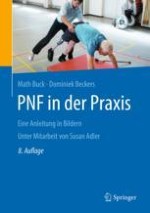Erschienen in:
2019 | OriginalPaper | Buchkapitel
7. Obere Extremitäten
Zusammenfassung
Armmuster sind mehrdimensionale Bewegungen, die spiralförmig in Rumpfdiagonalen verlaufen können. In diesem Kapitel werden die unterschiedlichen Bewegungsdialogen von Armen, Schulter, Handgelenk und Hand beschrieben.
Anzeige














